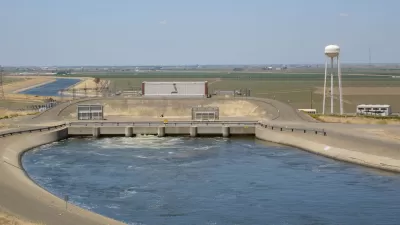Theft by illegal marijuana grow operations is straining California's already dwindling water supplies and endangering local communities as authorities lock hydrants and restrict access to water sources.

"As drought grips most of California, water thievery across the state has increased to record levels," writes Julie Cart, straining resources and causing concern in small communities dependent on scarce supplies.
Bandits in water trucks are backing up to rivers and lakes and pumping free water they sell on a burgeoning black market. Others, under cover of darkness, plug into city hydrants and top up. Thieves also steal water from homes, farms and private wells, and some even created an elaborate system of dams, reservoirs and pipelines during the last drought. Others are MacGyvering break-ins directly into pressurized water mains, a dangerous and destructive approach known as hot-tapping.
Northern California faces a similar problem as water theft has started to deplete the Russian River and other important waterways. "In one water district there, thefts from hydrants could compromise a limited water supply for fighting fires, which is why they have put locks on hydrants."
"No cache of water is safe. During the last major drought, businesses, schools and even a fire station were victims of water theft. In 2014, thieves pumped water from storage tanks belonging to the North San Juan Fire Protection District in Nevada County, in the mountains northeast of Sacramento." In the Sierra Nevada, Nevada County estimates that it is home to close to 4,000 illegal operations, while "[i]n the Antelope Valley, illegal grows have doubled from 200 last year to 400 today, according to county data, while other estimates put the number in the thousands."
While marijuana uses about the same amount of water as a tomato plant, all told, the illegal operations use around 5.4 million gallons per day, straining California's already limited supply as authorities struggle to understand and address the problem. "The state Water Resources Board, which has a modest cadre of 80 investigators who track water diversion and theft from California’s rivers and streams, cannot begin to keep up with the epidemic of stolen water. Nor is the agency’s $1,000 a day fine for water theft proving to be an effective deterrent to offset the rewards for a multi-billion dollar criminal industry." Recently, "the Los Angeles County Board of Supervisors, fed up with water theft and their lack of authority to address it, passed a resolution to petition state legislators to give them power to prosecute water theft, especially during severe droughts."
California can learn from Australia's experience with a similar issue. On the arid island nation, authorities created a powerful new agency to stem the illegal siphoning of water. The agency includes "a large enforcement team backed by fines and the threat of revocation of water licenses" and uses "satellite images, drones, remote-controlled watercraft and software that compares what’s growing on farms with their legal water allocation." As droughts intensify and water becomes more scarce, California must take steps to enhance its own enforcement and protect this vital resource.
FULL STORY: Thieves are stealing California’s scarce water. Where’s it going? Illegal marijuana farms

Planetizen Federal Action Tracker
A weekly monitor of how Trump’s orders and actions are impacting planners and planning in America.

Canada vs. Kamala: Whose Liberal Housing Platform Comes Out on Top?
As Canada votes for a new Prime Minister, what can America learn from the leading liberal candidate of its neighbor to the north?

The Five Most-Changed American Cities
A ranking of population change, home values, and jobs highlights the nation’s most dynamic and most stagnant regions.

San Diego Adopts First Mobility Master Plan
The plan provides a comprehensive framework for making San Diego’s transportation network more multimodal, accessible, and sustainable.

Housing, Supportive Service Providers Brace for Federal Cuts
Organizations that provide housing assistance are tightening their purse strings and making plans for maintaining operations if federal funding dries up.

Op-Ed: Why an Effective Passenger Rail Network Needs Government Involvement
An outdated rail network that privileges freight won’t be fixed by privatizing Amtrak.
Urban Design for Planners 1: Software Tools
This six-course series explores essential urban design concepts using open source software and equips planners with the tools they need to participate fully in the urban design process.
Planning for Universal Design
Learn the tools for implementing Universal Design in planning regulations.
Central Transportation Planning Staff/Boston Region MPO
Heyer Gruel & Associates PA
Institute for Housing and Urban Development Studies (IHS)
City of Grandview
Harvard GSD Executive Education
Regional Transportation Commission of Southern Nevada
Toledo-Lucas County Plan Commissions





























